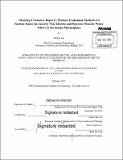| dc.contributor.advisor | Susan Murcott. | en_US |
| dc.contributor.author | Liu, Shuyue, S.M. Massachusetts Institute of Technology | en_US |
| dc.contributor.other | Massachusetts Institute of Technology. Department of Civil and Environmental Engineering. | en_US |
| dc.coverage.spatial | a-ii--- | en_US |
| dc.date.accessioned | 2015-07-17T19:47:41Z | |
| dc.date.available | 2015-07-17T19:47:41Z | |
| dc.date.copyright | 2015 | en_US |
| dc.date.issued | 2015 | en_US |
| dc.identifier.uri | http://hdl.handle.net/1721.1/97798 | |
| dc.description | Thesis: S.M., Massachusetts Institute of Technology, Department of Civil and Environmental Engineering, 2015. | en_US |
| dc.description | Cataloged from PDF version of thesis. | en_US |
| dc.description | Includes bibliographical references (pages 113-115). | en_US |
| dc.description.abstract | Household Water Treatment and Storage (HWTS) products provides households that are drinking unimproved water supplies with a first line of defense against contaminants in their drinking water and those drinking improved water supplies with an additional barrier against potential risks. With the global water crisis becoming more and more severe, evaluation of HWTS technologies and products has become crucial to ensure they are used to remove impurities effectively. The goal of this thesis was to evaluate household water filters in the Indian marketplace as part of a larger research and technology evaluation to investigate the utilization and performances of different water filter models in both lab and field settings. This was achieved by comparative testing and research work done at Consumer Reports (CR) Headquarters in Yonkers, NY. This evaluation included the testing of three categories of filters: Conventional Particle Removal (cloth and mesh), Gravity Non-Electric (GNE) and Reverse Osmosis (RO) water filters. In total, 16 models were tested. The challenge water for all filter testing had these characteristics: 40+/-10 NTU turbidity and 1500+/-150mg/L total dissolved solids (TDS). When testing E.coli removal, deionized water was used as the base water and the concentration of E. coli was 10⁵ to 10⁶ MPN (Most Probable Number)/100mL. The comparative testing attributes that were evaluated include: E.coli removal, turbidity removal, TDS removal, clean water flow rate, RO % recovery, and filter lifetime with the end-of-life defined as when flow rate <1 L/hr. As a result of this product evaluation, the author determined that: 1) Cloth and mesh filters had limited effectiveness in reducing contaminants; 2) GNE filters had much better performance than cloth and mesh filters, but none of them had outstanding performance; 3) RO filters were shown to be quite effective in reducing turbidity (greater than 99.5%), TDS (greater than 97%), and E.coli (greater than 99.9999%). But, they produce a large amount of wastewater (around 3/4 of the feed water) which is a huge waste of precious water and a sustainability concern especially in a water scarce region. | en_US |
| dc.description.statementofresponsibility | by Shuyue Liu. | en_US |
| dc.format.extent | 115 pages | en_US |
| dc.language.iso | eng | en_US |
| dc.publisher | Massachusetts Institute of Technology | en_US |
| dc.rights | M.I.T. theses are protected by copyright. They may be viewed from this source for any purpose, but reproduction or distribution in any format is prohibited without written permission. See provided URL for inquiries about permission. | en_US |
| dc.rights.uri | http://dspace.mit.edu/handle/1721.1/7582 | en_US |
| dc.subject | Civil and Environmental Engineering. | en_US |
| dc.subject | Water Filter Evaluation in India | |
| dc.title | Adapting Consumer Report's product evaluation methods for particle removal, gravity non-electric and reverse osmosis water filters in the Indian marketplace | en_US |
| dc.type | Thesis | en_US |
| dc.description.degree | S.M. | en_US |
| dc.contributor.department | Massachusetts Institute of Technology. Department of Civil and Environmental Engineering | |
| dc.identifier.oclc | 911943244 | en_US |
